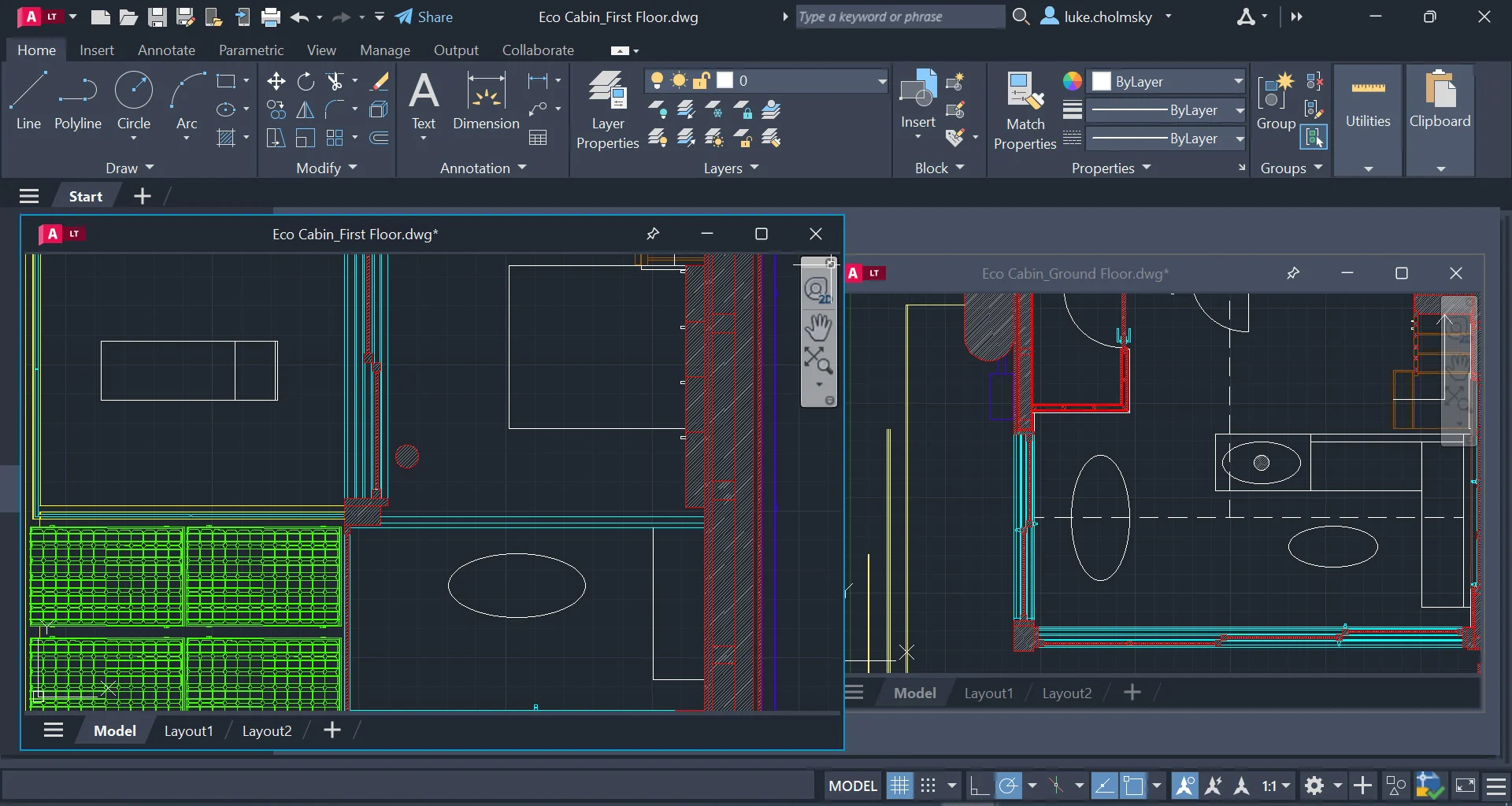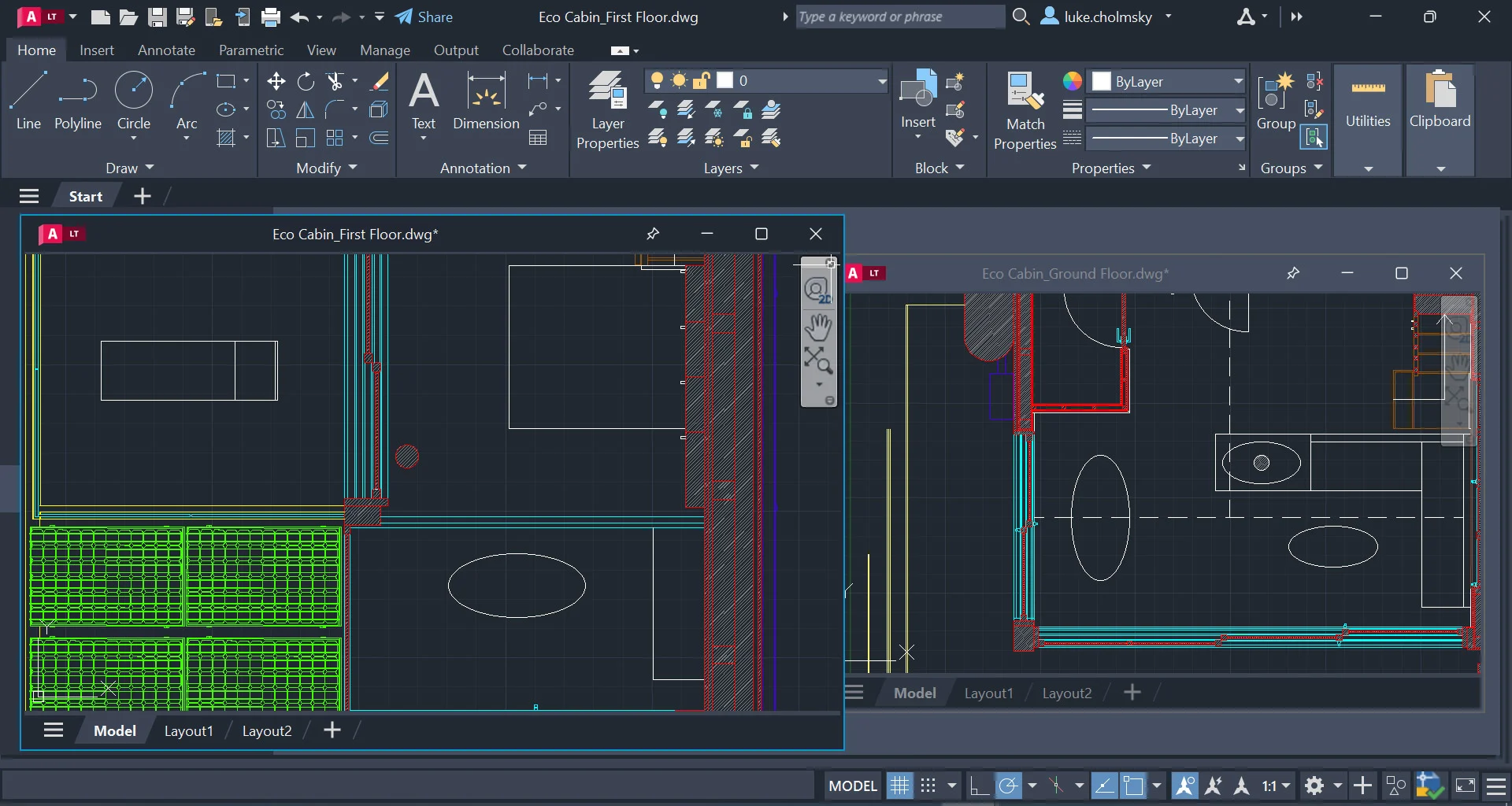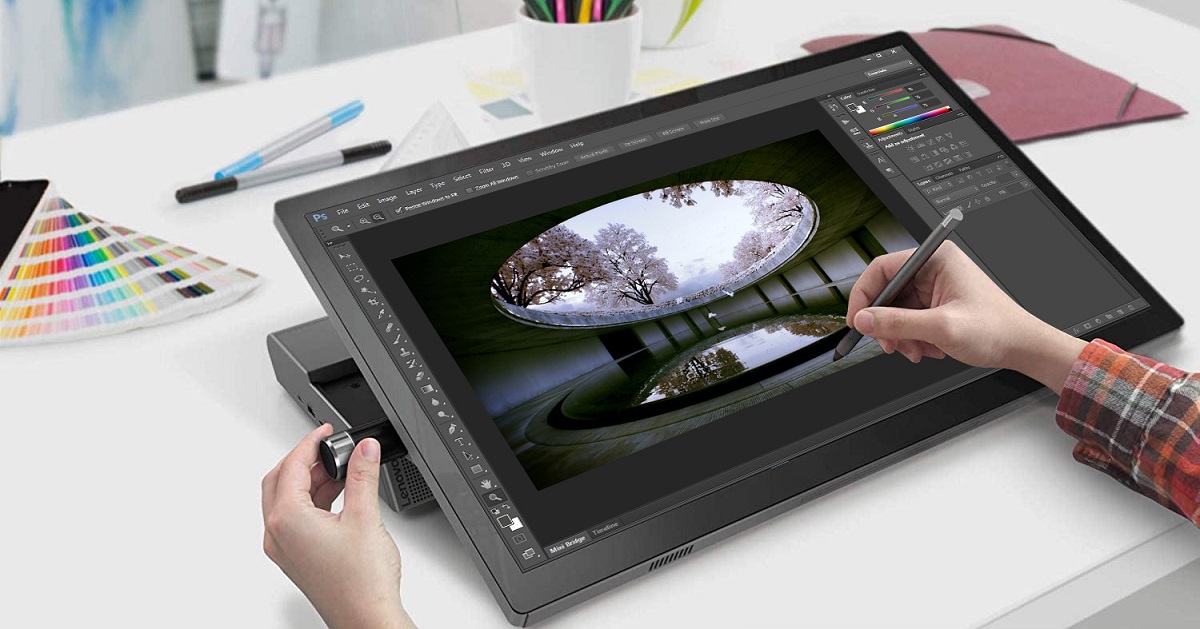Introduction
Welcome to the world of AutoCAD, where precision meets creativity and innovation. AutoCAD is a powerful software used by architects, engineers, and designers to create intricate 2D and 3D models. It offers a multitude of features and extensive tools that enable professionals to bring their designs to life.
As an AutoCAD user, you understand the importance of having a computer system that can handle the demands of this robust software. One crucial component that greatly impacts the performance of AutoCAD is the amount of RAM (Random Access Memory). RAM plays a vital role in ensuring smooth operation and efficient workflow.
In this article, we will explore the significance of RAM in an AutoCAD environment and how it can impact your overall experience. We will also provide recommendations on the ideal RAM capacity for different types of AutoCAD workloads and discuss the various factors that affect RAM requirements.
Understanding the relationship between AutoCAD and RAM will not only help you make informed decisions when purchasing or upgrading your computer system, but it will also enable you to optimize your software performance for a seamless design experience.
What is AutoCAD?
AutoCAD, developed and marketed by Autodesk, is a computer-aided design (CAD) software that has become the industry standard for architectural, engineering, and design professionals. It provides a comprehensive set of tools for creating, editing, and documenting 2D and 3D digital drawings and models.
With AutoCAD, designers can draft and annotate precise geometric shapes, generate technical drawings, and create detailed visualizations of their designs. The software offers a wide range of features, including layers, dimensions, blocks, and libraries, allowing users to create complex designs with precision and efficiency.
What sets AutoCAD apart is its versatility. It is used across various industries, including architecture, engineering, construction, manufacturing, and product design. Architects and engineers rely on AutoCAD to create detailed floor plans, elevations, and sections. Manufacturing companies use it to design and visualize their products, while product designers use it for concept development and prototyping.
AutoCAD’s extensive capabilities go beyond just creating 2D and 3D models. It also offers modules for rendering, simulation, and animation, allowing users to create realistic visualizations and walkthroughs of their designs. This versatility makes AutoCAD an essential tool for project planning, communication, and collaboration.
Over the years, AutoCAD has evolved and introduced new features to meet the ever-changing demands of the design industry. It has expanded to include specialized versions like AutoCAD Architecture, AutoCAD Civil 3D, and AutoCAD Electrical, catering to the unique requirements of different disciplines. These specialized versions provide additional tools and functionality tailored to the respective fields.
AutoCAD’s widespread use and compatibility with other software and file formats make it a collaborative platform that allows professionals to work seamlessly with clients, consultants, and team members. It supports interoperability with other Autodesk products, as well as commonly used file formats such as DWG, DXF, and PDF.
In summary, AutoCAD is a versatile CAD software that empowers professionals in various industries to bring their design ideas to life. Its robust toolset, extensive capabilities, and interoperability have made it an indispensable tool for architects, engineers, and designers worldwide.
The Importance of RAM in AutoCAD
When working with AutoCAD, having sufficient RAM is critical to ensure optimal performance and productivity. RAM acts as a temporary storage space where the software can quickly access and manipulate data while working on complex drawings and models.
AutoCAD is a memory-intensive software that requires a significant amount of RAM to handle the large amounts of data involved in creating intricate designs. Insufficient RAM can result in slow loading times, lagging commands, and crashes, ultimately hampering your workflow and efficiency.
As you work on your designs in AutoCAD, the software must constantly store and retrieve information from RAM. The more RAM you have, the more data AutoCAD can handle at once, allowing for smooth navigation, responsiveness, and real-time rendering.
In addition to improving overall performance, having ample RAM in your system enables AutoCAD to handle larger file sizes without slowing down. It allows you to work on complex drawings with high levels of detail and multiple layers, ensuring that your computer can keep up with your design aspirations.
RAM also plays a crucial role in enabling multi-tasking capabilities. With sufficient RAM, you can run AutoCAD alongside other software applications or processes without experiencing significant slowdowns. This is particularly valuable when using resource-intensive software like 3D rendering or engineering analysis tools alongside AutoCAD.
Moreover, having enough RAM is essential for swift and efficient rendering of 3D models and visualizations. When rendering, AutoCAD utilizes system resources, including RAM, to process and display the intricate details of your designs. Sufficient RAM allows for faster rendering times and smoother performance, enabling you to produce high-quality visualizations more efficiently.
It’s important to note that the RAM requirements for AutoCAD may vary depending on the complexity of your designs and the size of your project files. Working on large-scale projects or handling multiple projects simultaneously may require additional RAM to ensure optimal performance.
In summary, having an adequate amount of RAM is vital for a seamless AutoCAD experience. It improves performance, enables handling of larger file sizes, supports multi-tasking capabilities, and facilitates efficient rendering of 3D models. Investing in RAM upgrades or opting for a system with sufficient RAM will significantly enhance your productivity and enable you to unleash your creativity without restraints.
Recommended RAM for AutoCAD
When it comes to determining the amount of RAM required for AutoCAD, several factors need to be considered, including the complexity of your designs, the size of your project files, and the version of AutoCAD you are using. While the specific RAM requirements may vary, here are some general recommendations to ensure optimal performance:
- Minimum RAM: For basic 2D drafting and lightweight 3D modeling, a minimum of 8GB of RAM is recommended. This should be sufficient for smaller projects and simple designs.
- Recommended RAM: To handle more complex drawings or extensive 3D modeling, a minimum of 16GB to 32GB of RAM is recommended. This will provide a smoother experience and allow for faster processing and rendering of your designs.
- Large-scale or Complex Projects: If you are working on larger-scale projects or dealing with highly detailed 3D models, it is advisable to have even more RAM. For such scenarios, 32GB to 64GB of RAM or more may be necessary to ensure optimal performance.
- RAM for Rendering: If rendering is a significant part of your workflow, additional RAM is recommended. The more RAM you have, the faster the rendering process, resulting in quicker production of high-quality visualizations.
Keep in mind that these recommendations are based on typical usage scenarios and may vary depending on your specific requirements and the complexity of your designs. It is always beneficial to have more RAM than the minimum recommended amount, as it allows for smoother performance and better future-proofing of your system.
Additionally, when choosing RAM, consider the speed and type of RAM that is compatible with your computer. Faster RAM, such as DDR4, can provide better performance compared to older generations. Check the specifications of your system and consult with hardware experts to ensure you select the appropriate RAM modules for your computer.
Lastly, it’s important to note that while RAM is a crucial component for AutoCAD, it is not the sole factor that determines performance. A well-rounded system with a powerful processor, a dedicated graphics card, and fast storage drives will further enhance your AutoCAD experience and improve overall productivity.
In summary, for optimal performance in AutoCAD, it is recommended to have a minimum of 8GB to 32GB of RAM, depending on the complexity of your designs and the size of your project files. Consider your specific requirements and consult with professionals to ensure you choose the appropriate RAM capacity and type for your computer system.
Factors Affecting RAM Requirements
There are several factors that can influence the RAM requirements for AutoCAD. Understanding these factors will help you determine the appropriate amount of RAM needed to ensure optimal performance in your specific workflow. Here are some key factors to consider:
- Complexity of Designs: The complexity of your designs plays a significant role in determining the RAM requirements. Highly detailed 3D models with intricate geometry and large file sizes require more RAM to handle the data effectively. Complex assemblies, rendering-intensive tasks, and simulations all contribute to increased RAM usage.
- Project File Size: The size of your AutoCAD project files affects RAM usage. Larger files require more RAM to load and process efficiently. Handling multiple large-scale projects simultaneously or working with multi-sheet drawings can impact the amount of RAM needed.
- Number of Objects and Layers: The number of objects and layers in your drawings can impact RAM requirements. Designs with a significant number of objects, particularly when using complex blocks and symbols or extensive layering, consume more RAM as AutoCAD needs to manage and manipulate the data for display and editing.
- Use of Resource-Intensive Features: Utilizing resource-intensive features within AutoCAD, such as advanced rendering, 3D modeling with complex materials and lighting effects, or performing complex analysis or simulations, can significantly increase the RAM requirements. These features rely on RAM for data processing and temporary storage.
- Operating System and Other Software: The RAM requirements for AutoCAD can also be influenced by the operating system and other software running simultaneously. Running resource-intensive applications alongside AutoCAD or using memory-intensive tools like virtual machines can reduce the available RAM for AutoCAD, impacting its performance.
- Future-Proofing: It is important to consider future project requirements and anticipated growth when determining RAM requirements. Investing in additional RAM beyond the immediate needs can help ensure that your system remains capable of handling more demanding projects in the future.
It is recommended to carefully assess these factors in conjunction with your specific workflow and project requirements to determine the ideal amount of RAM for your AutoCAD setup. Consultants and hardware experts can provide valuable insights based on their experience and knowledge of hardware configurations suitable for AutoCAD.
Remember that the RAM requirements may vary from one project to another, and it is always beneficial to have more RAM than the minimum recommended amount to accommodate unforeseen demands and to optimize your AutoCAD experience.
In summary, factors such as the complexity of designs, project file size, number of objects and layers, use of resource-intensive features, the operating system, and future-proofing considerations all impact the RAM requirements for AutoCAD. It is important to assess these factors in relation to your specific workflow to determine the appropriate amount of RAM needed for optimal performance.
Understanding AutoCAD Workloads
AutoCAD workloads refer to the specific tasks and activities performed within the software. Understanding your typical AutoCAD workloads is essential for determining the RAM requirements and optimizing your system for optimal performance. Here are some common AutoCAD workloads and how they can impact RAM usage:
- 2D Drafting: 2D drafting involves creating precise 2D drawings, such as floor plans, elevations, and sections. While 2D drafting is generally less demanding on system resources, the RAM requirement can increase depending on the complexity and size of the drawings, the number of objects and lines used, and the use of references and layering.
- 3D Modeling: 3D modeling involves creating and manipulating 3D objects and assemblies. As 3D models contain more data and geometry, they tend to be more resource-intensive and can significantly impact RAM usage. The complexity of the models, the number of objects, the level of detail, and the use of materials and textures all contribute to increased RAM requirements.
- Rendering: Rendering involves creating photorealistic images or animations of your designs. Rendering tasks are highly resource-intensive, primarily relying on RAM for storing and processing the data required for generating the visual outputs. RAM requirements for rendering can increase based on the size and complexity of the scene, the number of light sources, the level of detail, and the quality settings selected.
- Simulation and Analysis: AutoCAD offers simulation and analysis tools that allow for testing and validating designs. These tasks involve performing calculations, analyzing stress and deformation, and simulating real-world scenarios. The RAM requirements for simulation and analysis can vary based on the complexity of the model, the number of elements being analyzed, and the level of precision required.
- Collaboration and Documentation: AutoCAD is often used for collaboration and documenting designs. Tasks such as creating construction documentation, generating drawing sets, and collaborating with team members or clients can impact RAM usage, especially when handling multiple drawings, extensive layering, and referencing large files.
It’s essential to evaluate your typical AutoCAD workloads and identify which tasks are more demanding in terms of RAM usage. This analysis will help you understand the maximum RAM requirements you may encounter during your work and allow you to make informed decisions when configuring your system.
Keep in mind that your specific workload may involve a combination of these tasks, and the RAM requirements can vary depending on the complexity and scale of your projects. It is recommended to consult with experienced AutoCAD users or professionals in your field to gain insights into the typical RAM requirements for your specific workflows.
In summary, understanding your AutoCAD workloads is crucial for determining the RAM requirements of your system. Tasks such as 2D drafting, 3D modeling, rendering, simulation and analysis, and collaboration and documentation can impact RAM usage. Analyzing your specific workloads will help you identify the RAM needed to optimize performance and enhance your AutoCAD experience.
How to Determine the Amount of RAM You Need
Determining the appropriate amount of RAM needed for your AutoCAD system requires careful consideration of various factors and an understanding of your specific workflow. Here are some steps to help you determine the amount of RAM you need:
- Assess your typical AutoCAD workloads: Evaluate the types of tasks you commonly perform in AutoCAD, such as 2D drafting, 3D modeling, rendering, or simulation. Identify the workloads that are more resource-intensive and likely to have a higher impact on RAM usage.
- Estimate the complexity of your designs: Consider the complexity of your designs and the size of your project files. Reflect on the level of detail, number of objects, and layering involved in your typical projects. Complex designs and larger files will require more RAM to handle the data effectively.
- Consider future project requirements: Anticipate the growth of your projects and the potential increase in complexity. If you expect to work on larger-scale projects or more demanding designs, it is advisable to allow for additional RAM to accommodate future requirements.
- Consult with experienced users or professionals: Seek advice from experienced AutoCAD users or professionals in your field. They can provide valuable insights based on their own experiences and help you understand the typical RAM requirements for your specific workflow and project types.
- Review software and hardware recommendations: Check the Autodesk website, forums, and documentation for recommended RAM specifications for the version of AutoCAD you are using. Also, refer to hardware guidelines provided by Autodesk to understand the minimum and recommended system requirements for optimal performance.
- Consider the capabilities of your current system: Evaluate your current system specifications and determine if an upgrade is necessary. Take into account your current RAM capacity, processor speed, graphics card, and storage drives. Upgrading only the RAM may not fully optimize your system if other components are outdated or underpowered.
- Allocate a sufficient budget: Once you have determined the RAM capacity you need, allocate a budget for the upgrade or the purchase of a new system. Consider the cost of RAM modules and any other necessary hardware upgrades to ensure a balanced and capable system.
By following these steps, you can obtain a better understanding of the RAM requirements for your AutoCAD system, enabling you to make informed decisions when selecting or upgrading your computer hardware.
Remember, the RAM requirements may vary depending on your specific projects and workflows. It is always recommended to have more RAM than the minimum recommended amount to allow for smoother performance and better accommodatetion of your future needs.
In summary, determining the amount of RAM you need for AutoCAD involves assessing your typical workloads, estimating the complexity of your designs, considering future project requirements, consulting with experienced users or professionals, reviewing software and hardware recommendations, evaluating your current system, and allocating a sufficient budget. Through this process, you can ensure that your AutoCAD system is equipped with the appropriate amount of RAM to handle your specific workload and optimize performance.
Upgrading RAM for Better Performance in AutoCAD
Upgrading the RAM in your system can significantly improve the performance of AutoCAD and enhance your overall design experience. Here are some key considerations and steps to follow when upgrading the RAM for better performance in AutoCAD:
- Determine the desired RAM capacity: Based on your assessment of AutoCAD workloads and project requirements, determine the ideal RAM capacity for your needs. Consider the complexity of your designs, the size of your project files, and the recommended RAM specifications outlined by Autodesk.
- Check compatibility: Ensure that the RAM modules you plan to purchase are compatible with your computer system. Consider factors such as the RAM type (DDR3, DDR4, etc.), speed, and maximum supported capacity of your motherboard to ensure seamless integration.
- Allocate a budget: Determine a budget for the RAM upgrade and research different options available within your price range. Compare prices, read reviews, and consider reputable brands to ensure a reliable and quality purchase.
- Decide on additional hardware upgrades: Assess your current system specifications and determine if any additional hardware upgrades are necessary or recommended. Upgrading RAM alone may not optimize performance if other components, such as the processor or storage drive, are outdated or underpowered.
- Shut down your computer and disconnect power: Before physically installing the new RAM modules, shut down your computer and disconnect it from the power source. This will ensure safety during the installation process.
- Locate and access RAM slots: Identify the RAM slots on your motherboard where the new modules will be installed. Refer to your computer’s user manual or online resources for guidance on locating and accessing these slots.
- Remove existing RAM modules (if applicable): If you are replacing existing RAM modules, carefully remove them from their slots. Release the locking mechanisms and gently pull the modules out at an angle. Follow proper handling guidelines to avoid damage.
- Install new RAM modules: Align the notches on the new RAM modules with the slots on the motherboard. Insert the modules at an angle and press them firmly until they click into place. Ensure that the locking mechanisms engage to secure the modules.
- Reconnect power and start your computer: Once the new RAM modules are installed, reconnect the power cable and start your computer. The system should recognize the upgraded RAM capacity upon booting up.
- Update system BIOS and test performance: Check for any available updates for your system’s BIOS (Basic Input/Output System) and ensure that it is up to date. Then, run AutoCAD and test the performance to evaluate the improvement in speed, responsiveness, and handling of complex designs.
By following these steps, you can successfully upgrade the RAM in your system for better AutoCAD performance. However, it is important to note that upgrading RAM alone may not be a cure-all for performance issues. It is recommended to have a well-rounded system with adequate RAM, a powerful processor, a dedicated graphics card, and fast storage drives to optimize AutoCAD performance.
In summary, upgrading the RAM in your system can greatly enhance AutoCAD performance. Determine the desired RAM capacity, ensure compatibility, allocate a budget, consider additional hardware upgrades, follow proper installation procedures, test performance, and optimize your system as needed. By carefully upgrading your RAM, you can unlock the full potential of AutoCAD and improve your productivity and design capabilities.
Tips to Optimize RAM Usage in AutoCAD
Optimizing RAM usage in AutoCAD is crucial to ensure smooth performance and efficient workflow. Here are some helpful tips to help you optimize RAM usage in AutoCAD:
- Close unnecessary applications and processes: Before launching AutoCAD, close any unnecessary applications and processes running in the background. This frees up system resources, including RAM, for AutoCAD to utilize effectively.
- Limit the number of open drawings: Avoid having an excessive number of drawings open simultaneously in AutoCAD. Each open drawing consumes RAM, and having too many open can strain your system resources. Close any drawings that are not currently needed.
- Purge unused elements: Regularly purge and clean your drawings to remove any unused blocks, layers, linetypes, or other elements. This helps reduce the size of the drawing file and conserves RAM usage when working with the design.
- Optimize display settings: Adjust your AutoCAD display settings to strike a balance between visual quality and performance. Reduce the complexity of visual styles, limit the level of detail shown in the viewport, and disable unnecessary visual effects to conserve RAM and improve performance.
- Use external references (Xrefs) wisely: When working with complex projects, utilize external references (Xrefs) to link and manage various parts of the design. Instead of maintaining multiple copies of the same object, Xrefs allow you to load and unload the referenced data as needed, reducing RAM usage.
- Utilize layer management: Properly manage and organize your layers in AutoCAD. Avoid excessive layering and unnecessary layer duplication, as each layer consumes additional system resources. Well-structured layers not only optimize RAM usage but also enhance drawing organization and ease of navigation.
- Opt for lightweight objects: Whenever possible, utilize lightweight objects such as polylines or hatches instead of more resource-intensive objects like complex blocks. Using lightweight objects reduces the amount of data stored in RAM and improves overall performance.
- Minimize regenerations: Excessive and frequent regenerations of the drawing—often triggered by zooming, panning, or modifying the design—can strain system resources. Minimize unnecessary regenerations by utilizing techniques like freezing or turning off certain layers during editing.
- Regularly save and backup your drawings: AutoCAD automatically allocates a portion of RAM for temporary storage while working on drawings. To avoid excessive RAM usage, save your work frequently and make backups to release the allocated RAM and improve system performance.
- Optimize your system hardware: Beyond optimizing RAM usage within AutoCAD, ensure that your system hardware, including the processor, graphics card, and storage drives, is well-suited for running AutoCAD smoothly. A well-rounded system can complement RAM optimization efforts.
Implementing these tips will help you optimize RAM usage in AutoCAD and ensure a more efficient and smooth design experience. Keep in mind that the specific optimization techniques may vary based on your project requirements and the complexity of your designs.
In summary, optimizing RAM usage in AutoCAD involves closing unnecessary applications, limiting the number of open drawings, purging unused elements, optimizing display settings, using Xrefs wisely, managing layers efficiently, utilizing lightweight objects, minimizing regenerations, saving and backing up drawings regularly, and optimizing your system hardware. By following these tips, you can maximize RAM utilization, enhance performance, and improve your overall AutoCAD workflow.
Conclusion
RAM plays a critical role in enhancing the performance of AutoCAD, a powerful software used by professionals in various design and engineering fields. With the right amount of RAM, you can ensure smooth navigation, quick rendering, and efficient handling of complex designs.
In this article, we have explored the importance of RAM in AutoCAD and provided recommendations for the ideal RAM capacity based on different workloads. We discussed factors that impact RAM requirements, such as design complexity, project file size, and the use of resource-intensive features. Additionally, we provided tips on how to determine the amount of RAM you need and how to optimize RAM usage in AutoCAD.
When considering an upgrade, it is important to evaluate your typical AutoCAD workloads, estimate the complexity of your designs, consult with experienced users or professionals, and check recommended specifications. Upgrading the RAM in your system, in conjunction with a well-rounded hardware configuration, can significantly improve AutoCAD performance and enhance your productivity.
Remember that AutoCAD workloads and project requirements may vary, and it is always beneficial to have more RAM than the minimum recommended amount to accommodate future growth and unforeseen demands. Additionally, optimizing RAM usage in AutoCAD through proper file management, display settings, and system maintenance can further enhance performance.
By understanding the significance of RAM and implementing best practices for RAM utilization, you can unlock the full potential of AutoCAD and create remarkable designs with speed and efficiency.

























